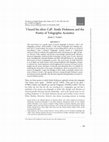Publications by Justin Tackett
Review of English Studies, 2023

Los Angeles Review of Books, 2021
ALTHOUGH 2021 CONTINUES to be a year of unbearable deaths, it's also a year of uncanny resurrecti... more ALTHOUGH 2021 CONTINUES to be a year of unbearable deaths, it's also a year of uncanny resurrections. On February 23, the bicentennial of Romantic poet John Keats's death, I decided to walk to his London home. When I arrived at the long white house in Hampstead, however, there were few signs of the momentous anniversary because of the pandemic. Somewhat dejected, I returned to my flat instead to watch a Zoom celebration that debuted the Institute for Digital Archaeology's reconstruction of the poet, based on contemporary images and masks, that could gesture and recite his poems, accent and all. Filled with a mixture of wonder and enthusiasm for future improvement of this developing technology (it still bore the geodesic surfaces of many digital likenesses built from scratch), I was mostly warmed by the feeling of collective global appreciation for a poet none of us had met, as well as the potential to revivify him for students and the public. Then Deep Nostalgia happened. Just two days after Keats's bicentennial, the Israeli genealogy site MyHeritage released Deep Nostalgia, a technology developed by Israeli security company DID (De-Identification) as part of their "reenactment suite," that animates human faces in photographs, making them look around, nod, smile, wink, and even dance. Riding my techno-high, I created an account and uploaded paintings of Keats. To my delight, the Romantic poet was soon blowing kisses at me through the screen. It was mesmerizing. According to MyHeritage, Deep Nostalgia is a way to bring to life photographs of dead ancestors and famous people. The technology took social media by storm, and users have generated nearly 100 million animations, including ones of

Review of English Studies, 2019
This essay focuses on a specific aspect of electric telegraphy in America-what I call 'telegraphi... more This essay focuses on a specific aspect of electric telegraphy in America-what I call 'telegraphic acoustics', which includes: 1) the sound of telegraph wires vibrating overhead and 2) 'sound-reading', the practice of transcribing Morse code by ear instead of transcribing it from a printout. Telegraphic acoustics started as a distinctively American technical evolution that emphasized sound and listening over sight and literacy. Because of this emphasis and because of increasingly universal poetic education, American telegraphers understood their technology in poetic terms. In turn, American poets, including John Greenleaf Whittier and Oliver Wendell Holmes Sr., also thought about poetry in terms of telegraphic acoustics. The essay focuses on Emily Dickinson as an in-depth case study because of her unusual familiarity with telegraphic acoustics in Amherst; her visual impairment, which heightened her awareness of sound; and her insights into the nature and future of networks and information flow. It concludes by examining the intersection of her poetry and telephony, which was perceived as an extension of telegraphy. I argue that thinking of these media acoustically, instead of in terms of literacy, reveals a rich separate discourse running through Dickinson's poetry and American poetry generally. This discourse demands reinterpretations of several ca-nonical Dickinson poems.
Thomas Hardy Journal, 2019
The Hopkins Quarterly, 2015
Uploads
Publications by Justin Tackett